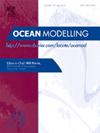不同强迫源下纽约-新泽西港三维非结构网格模型评价
IF 2.9
3区 地球科学
Q2 METEOROLOGY & ATMOSPHERIC SCIENCES
引用次数: 0
摘要
本文以纽约-新泽西(NY-NJ)港为例,对不同强迫源下的三维非结构化网格模型进行了深入评估。该模型首先通过控制运行进行校准和评估,确保它准确捕获NY/NJ港口周围的基本过程。敏感性实验强调了不同强迫源在总水位、海流、盐度和水温等沿海海洋条件下的重要作用和贡献。FES2014、TPXO9 v1和TPXO9 v5对潮分量、总水位、水流和水温的影响显著,对盐度的影响最小。来自HRRR、ERA5和GFS的地表强迫对水温预测的影响是可变的,而总水位、海流和盐度对不同大气强迫源的敏感性较低。CMEMS、HYCOM和GRTOFS的不同开放海洋条件对内陆河和河口水动力变量的影响较小,但对海流和大陆架水温垂直结构的影响较大。USGS和NWM的不同河流流量对盐度和上游水位具有很高的敏感性,而不同河流流量的大陆架尺度洋流和水温垂直结构相似。研究结果强调了选择最佳强迫源的必要性,以尽量减少不确定性并增强预测能力,从而支持在沿海管理和减灾方面做出更好的决策。本文章由计算机程序翻译,如有差异,请以英文原文为准。
Evaluation of a 3D unstructured grid model for the New York-New Jersey Harbor under different forcing sources
This paper presents an in-depth evaluation of a 3D unstructured grid model under various forcing sources, with a focus on the New York-New Jersey (NY-NJ) harbor. The model is first calibrated and evaluated through control runs, ensuring it accurately captures essential processes around the NY/NJ harbor. The sensitivity experiments highlight the significant roles and contributions of different forcing sources in coastal ocean conditions such as total water level, currents, salinity, and water temperature. Different tidal forcings, including FES2014, TPXO9 v1, and TPXO9 v5, show significant effects on tidal components, total water levels, currents, and water temperature, with minimal impact on salinity. Surface forcings from the HRRR, ERA5, and GFS demonstrate variable influences on water temperature predictions, while total water level, currents, and salinity are less sensitive to the different atmospheric forcing sources. Different open ocean conditions from CMEMS, HYCOM, and GRTOFS exhibited minor impacts on hydrodynamic variables in the inland rivers and estuaries but noticeably affected ocean surface currents and vertical structures of water temperature on the continental shelf. Different river discharges from USGS and NWM show high sensitivities of salinities and upstream water levels while shelf-scale ocean currents and vertical structures of water temperatures are similar across the different river discharges. The findings emphasize the necessity of selecting optimal forcing sources to minimize uncertainties and enhance predictive capabilities, supporting better decision-making in coastal management and hazard mitigation.
求助全文
通过发布文献求助,成功后即可免费获取论文全文。
去求助
来源期刊

Ocean Modelling
地学-海洋学
CiteScore
5.50
自引率
9.40%
发文量
86
审稿时长
19.6 weeks
期刊介绍:
The main objective of Ocean Modelling is to provide rapid communication between those interested in ocean modelling, whether through direct observation, or through analytical, numerical or laboratory models, and including interactions between physical and biogeochemical or biological phenomena. Because of the intimate links between ocean and atmosphere, involvement of scientists interested in influences of either medium on the other is welcome. The journal has a wide scope and includes ocean-atmosphere interaction in various forms as well as pure ocean results. In addition to primary peer-reviewed papers, the journal provides review papers, preliminary communications, and discussions.
 求助内容:
求助内容: 应助结果提醒方式:
应助结果提醒方式:


